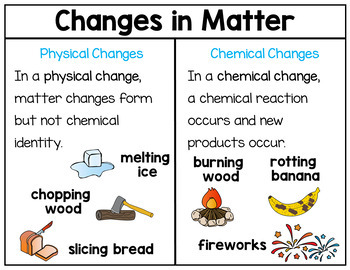Matter is an important part of our everyday lives. It can be found in the air we breathe, the food we eat, and the water we drink. When matter undergoes changes, it is either a physical or a chemical change. Physical changes involve a change in size, shape, or state of matter without changing its chemical composition. Chemical changes occur when substances react to form new products with different properties than the original substances.
Matter is the building blocks of our physical world, and it undergoes many changes over time. Whether it’s the natural aging process of materials or through the introduction of energy, matter experiences both physical and chemical changes. Physical changes involve a change in the material’s form or state, while chemical changes refer to the alteration of its internal structure. In this article, we will explore the different kinds of physical and chemical changes in matter, their causes, and their effects on the material itself.
What are 5 chemical and physical changes?
Chemistry is an incredibly interesting subject that can help us understand the world around us. It involves many different changes and reactions, both physical and chemical. In this article, we will explore five of the most common chemical and physical changes that occur in everyday life. We’ll explain each change in a simple, easy-to-understand way so that anyone can comprehend chemistry.
Chemical and physical changes are an essential part of the world around us, and understanding them is key to understanding our environment. In this article, we will look at five different types of chemical and physical changes that can occur in everyday life. We will explore what they are and how they affect the world around us. From burning wood to melting ice, these changes have a major impact on our lives.
What are 5 chemical changes matter?
Chemical changes in matter can have a huge impact on our environment and our lives. It is important to be aware of the five common types of chemical changes that occur in matter so you can understand how these changes are made and reacted to. Chemical changes happen when two or more substances interact to form a new substance with different properties than the original components, such as color, odor, taste, or even physical properties like boiling point.
Matter is made up of tiny particles called atoms. Matter can undergo various changes to form new substances. Chemical changes are one type of change that matter can undergo, and they involve forming new chemical bonds between atoms. These changes occur as a result of energy being released or absorbed. In this article, we will discuss five common examples of chemical changes in matter, including combustion, acid-base reactions, oxidation-reduction reactions, and hydrolysis.
What are 10 examples of physical changes?
Physical changes are changes in the state of an object or substance without any alteration to its chemical composition. These changes can range from breaking an object down into smaller pieces to altering the form of a substance without changing what it is made of. In this article, we will look at 10 examples of physical changes and how they occur. From melting ice cubes to boiling water, these physical changes are common occurrences that you may have experienced in everyday life.
Physical changes are alterations to a substance or object that affect its physical properties, such as shape, size, texture and color. There are many different types of physical changes that can occur and they can be used to create new materials with useful properties. In this article, we will explore 10 examples of physical changes and discuss the results of each change. We will also explain how each type of physical change affects the original material or object.
What are 20 examples of chemical changes?
Chemical changes are a fundamental part of the world around us. Everything from cooking food to burning fuel involves chemical changes. Understanding these changes is important for both everyday activities and scientific study. In this article, we will explore 20 examples of chemical changes that take place in our environment and how they affect us. From combustion to decomposition, this article will provide a comprehensive overview of the different types of chemical changes that can occur.
Chemical changes are a fundamental part of both living and non-living things. Every day, the world around us is undergoing natural chemical changes. From cooking food to decaying vegetation, chemical processes are taking place in everything we interact with. Understanding what a chemical change is and being able to identify examples can be helpful for students in science classes as well as everyday activities. This article provides an overview of 20 different examples of chemical changes that occur on Earth.
Difference Between Physical and Chemical Change
The world around us is constantly changing. Through these changes, there are two distinct categories of change – physical and chemical. Physical changes occur when a substance changes its form or appearance, but the composition remains the same. Chemical changes involve a transformation of the elements that make up a matter. Understanding the difference between these two types of change can help us gain a better insight into how our environment functions.
The physical and chemical properties of matter are often easily confused, due to the complex laws that govern them. Have you ever wondered what makes a physical change different from a chemical change? In this article, we will explore the fundamental differences between physical and chemical changes. We will discuss how they differ in terms of the energy involved, the substances produced, and the resulting characteristics of each type of change. Additionally, real-life examples will be provided to help illustrate the concepts discussed.
